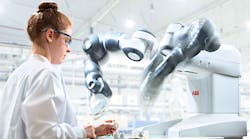We often speak about the technology (re)evolution that is driving the intelligent factory and Industry 4.0 –more robots, machines with embedded sensors that send signals to a networked factory, and machines that “talk” to each other and to the larger enterprise system. What we don’t often address is the role of the human in this intelligent factory operation.
Pundits claim that the intelligent factory will replace workers with machines and will obsolete human intuition and decision-making through artificial intelligence (AI). What these pundits get wrong is that not every job can—or should—be displaced with technology.
Instead, we should be thinking about how technology enhances human tasks and performance—which is why we at Intel recently studied over 150 workers from the factory floor to the C-suite, to better understand manufacturing workers’ pain points, their beliefs about the future of their operations, and their best guess for future technologies. What we learned surprised us.
A Call for Change
Regardless of position, workers in today’s factories expect change, both for themselves and for their companies. In fact, many indicated that the worst possible scenario of the future is one in which there is no change. And these study participants predicted that sweeping changes need to happen in the next three to five years.
While our results point to fewer humans in the future factory, it is clear that there are still tasks that will need human intervention. In fact, when we predict human roles in the future, the “Pit Boss” emerges as a new role. This person will be there “just in case” to monitor the outputs of all the sensors and AI recommendations and ensure that operations continue to run smoothly.
Workers also predict that more mundane and repetitive tasks will go away, thanks to smart technologies, and they welcome this. In fact, workers predict their jobs will become more transparent, more strategic, and more creative.
Mind the Gap
These same workers understand that their current skills are not necessarily ready for this transition. This is due to two gaps: (1) the skills gap and (2) the understanding gap. Both present serious challenges to those seeking a transition to an intelligent factory that is agile, highly reconfigurable, and able to produce products in small lots but with economies-of-scale prices.
The skills gap is not a new concept. Simply put, today’s workers need to be more data-savvy. They need to understand how data collected over time can result in increased operational transparency, reducing downtime. They need to be process experts and digital experts. As workers develop a deeper appreciation for the predictive value of data, they also will learn to trust it and take recommended actions from this data. Today this trust is sorely lacking.
In the near term however, there is a far greater gap that will affect the successful implementation of smart technologies—the understanding gap. In our study, workers are excited about the potential of “smart technologies” but seem to have only a limited understanding of the complexity of this tech.
From the factory floor to the C-suite, workers possess what we call magical thinking—"If I can slap a black box onto my machine, I will immediately get dashboards that provide insights into operation and into the factory as a whole.”
Before smart technology projects can yield operational and business value, this understanding gap must be bridged. We must be able to anticipate—and describe—the need for data collection at the machine level. This involves computing at or near the machine to manage bandwidth demands, and clearly translating operational efficiencies into AI algorithms. Many of these terms are not the normal lexicon of the factory, but need to become well-understood concepts.
Imagining Success in the Future Factory
The future workers entering the manufacturing environment are digital natives who are comfortable with—and expect—data, in order to drive transparency. However, these digital natives lack production experience. The current workforce possesses production experience, but lacks data knowledge. We need training programs that link these two populations and their belief systems to implement the future intelligent factory.
A successful intelligent factory of the future will embrace a digital culture where data informs decisions. Investments to get to this intelligent factory will need to be made in compute infrastructure, data management systems, integration of operational and information systems (the IT/OT convergence), and advanced algorithm software to cull insights from data streams. But the most important investments will need to be made in training—bringing the human in the loop along the intelligent factory journey.
Irene J. Petrick joined Intel in 2015 and is director of industrial innovation in Intel’s Internet of Things Group Irene focuses on emerging technology, social, and global trends and their combined impact on the industrial space. Prior to joining Intel, Irene was a faculty member at Penn State University in the College of Information Sciences and Technology (2003 – 2015) and the College of Engineering (2000-2003).










